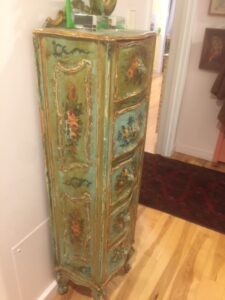 JD sent me an interesting lingerie chest someone painted wild green with floral designs. She asked: when the painting happened, and more importantly why? And she wants to know about the tradition of painted furniture. I find her question interesting because today the war wages between those who love color and those who love WHITE, stripped WOOD.
JD sent me an interesting lingerie chest someone painted wild green with floral designs. She asked: when the painting happened, and more importantly why? And she wants to know about the tradition of painted furniture. I find her question interesting because today the war wages between those who love color and those who love WHITE, stripped WOOD.
My 35 year-old-son loves real wood and he’d never paint “real” wood for the life of him. But through the 18th and 19th century Americans considered painted furniture more valuable than nonpainted, if the quality of the wood was subpar. We will see why. I understand why paint makes a good alternative, and I’m always ready to paint something! EXCEPT for pieces older than 1860.
No Good Wood? Paint it!
First, varnish, and GOOD WOOD, costs more than paint. A tradition grew up among early craftsmen that, if you didn’t use great wood—well, paint it. They used some unique paint. Sometimes, milk-based paint, when a painter only afforded a water based (not oil based) paint. The result came out beautiful when the painter added milk to the mix, which, over time, caused a crackled surface. We call that inexpensive circles now, desirable “Craquelure.”
As a kid in Deerfield, Illinois I made my mother crazy, because I painted all my furniture. I used wild colors, predominant 80s pink, yellow, and green. I painted my great-grandfather’s work box. I painted frames, my walls, my bed. But if you don’t own the finest furniture, what’s the harm of that?
Famous cabinetmakers made “copy books” that went to all over the word. 18th century cabinetmakers that started two separate and long term styles of furniture craft, George Hepplewhite (1727? – 1786) and William Sheraton (1815-1879), along with Chippendale, became two of the BIG THREE of English and American Furniture designers. In these “pattern” books, aimed at the local craftspeople in Australia, England, and America, they stated if one doesn’t have GREAT wood – paint it.
This caught on in the orphan schools of the early 19th century in England where the Nuns said, “if you can’t do anything useful, girls, you can paint furniture and boxes.” Some of those schoolgirl creations are sought after by English and American “primitive” collectors.
Today, according to my son
Walls should be WHITE, and trim, if wood, should be wood. But in the 18th and 19th century that was JUST the opposite. Walls were never white, and usually trim was painted. You see the importance of color in 18th and 19th century interiors, but we have gone full circle.
If you like painted furniture and want to gather historical ideas check out Schaffner and Klein’s American Painted Furniture 1790-1880 considered the heyday of painted furniture. I suspect once America overcomes their monochrome period in decorating, the fashion will return.
Much of the tradition of painting wood comes from immigrants to the US who didn’t have great wood to build furniture with, or a proper wall to put molding on. For example, immigrants to the Dakotas and Nebraska, mostly Mennonites, took large pieces of average wooden furniture and developed a “grain” paint that accentuated a grain in the wood not of the top quality. If they saw a rough patch, they accented the area with a nice painted motif.
French immigrants came early to Philadelphia, and painted furniture, especially in the French technique of gilding (with gold) to hide as well as to accent areas of so-so pieces.
JD’s piece comes from 18th century Venetian style, and Venice LOVED to paint furniture in the 18th century. This piece is a 20th version of that, and American furniture makers and painters of the 1930s-1940s loved this style and copied the Venetian tradition of the glam household. I do adore the greens, although I doubt many 35 year-old purist for white and blanched wood would love it as well.
Goes to show how tastes change. But I have news: the change MAY come again, so get out your paintbrushes.
My mom was infatuated with painting furniture. Now Annie Slogan’s chalk paint is becoming THE thing. Glenn has them at Miss Daisy’s Consignment at the old Sears location. Only SB outlet😉
Pls correct the name in my previous comment to : Annie Sloan
Thx